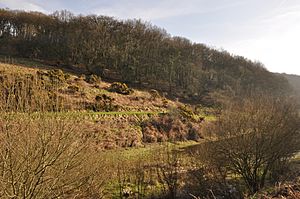Clatworthy Camp facts for kids
Quick facts for kids Clatworthy Camp |
|
|---|---|
 |
|
| Location | Wiveliscombe, Somerset, England |
| Area | 5.8 hectares (14 acres) |
| Built | Iron Age |
| Reference no. | 188442 |
| Lua error in Module:Location_map at line 420: attempt to index field 'wikibase' (a nil value). | |
Clatworthy Camp is an ancient hill fort from the Iron Age. It is located about 3 miles (5 km) northwest of Wiveliscombe in Somerset, England. This special site is protected as an Ancient Monument.
However, Clatworthy Camp is currently on the Heritage at Risk Register. This means it needs protection from things like overgrown bushes and trees. These can damage the old structures.
The exact history of Clatworthy Camp is not fully known. But it seems people used this area during both the Bronze Age and the Iron Age. The fort sits on a high point of the Brendon Hills, overlooking Clatworthy Reservoir.
It has a rough triangle shape and covers about 5.8 hectares (14 acres). The fort has one main bank and a ditch. These were dug right into the solid rock. There might have been an entrance on the west side. Two other entrances may have been on the east side. Inside the fort, archaeologists found holes where timber or stone houses once stood. They also found some storage pits.
In 2014 and 2015, Wessex Water helped protect the site. They cleared away trees and bracken (a type of fern). They were careful not to disturb any badger homes or places where bats might live. They also put up signs to teach visitors about the local wildlife.
What is a Hill Fort?
Hill forts are large, fortified settlements. People built them on hills during the Late Bronze Age and Early Iron Age. This was roughly around 1000 BC.
Historians and archaeologists have debated why these forts were built. Some think they were military sites. They might have been built to defend against invaders from other parts of Europe. Others believe they were built by invaders themselves. Another idea is that they were a way to deal with social problems. As more people lived in Britain, there was more pressure on farming land. This could lead to disagreements.
Many experts now believe that the use of iron changed society. Iron ore was found in different places than the tin and copper needed for bronze. This changed how people traded goods. Old leaders might have lost their power. New groups of people gained importance.
Archaeologist Barry Cunliffe suggests that more people also played a role. He believes hill forts offered a safe place for communities. They were useful when tensions led to open conflict. But he doesn't think they were built only because there was a constant state of war. They served as strongholds when needed. Some forts were attacked, but this wasn't the only reason they were built.
Images for kids



